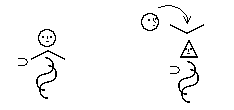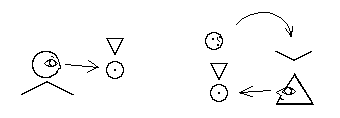1) Visually easy to understand
2) Small amount of simple ideograms systematically
increase ability of expressions; and one can save his/her effort for
memorization.
3) To make the context clear
about whose action or situation is shown by the verb phrase.
4) Not only human centered, but also nature/things centered thoughts can
go, and the custom might help to imagine others and co-work for our
common environment.
 -attached verb is for forming a kind of causative verb in English, but the
nuance is a little different to more natural way. This verb corresponds to
-attached verb is for forming a kind of causative verb in English, but the
nuance is a little different to more natural way. This verb corresponds to  -object
to form a predicate; and represent that the subject lets the
-object
to form a predicate; and represent that the subject lets the  -object
act or makes into the condition shown by the verb phrase, or the subject
make the condition that the object acts as the verb shows.
-object
act or makes into the condition shown by the verb phrase, or the subject
make the condition that the object acts as the verb shows.
E.g.: itself means
"eye" as a noun. Joining a verb symbol and
itself means
"eye" as a noun. Joining a verb symbol and  makes various verbs, adding the meaning of "(someone's) eyes
act". According to the types of verb, the owner of the eyes are
different in their meaning.
makes various verbs, adding the meaning of "(someone's) eyes
act". According to the types of verb, the owner of the eyes are
different in their meaning.
(1)





 : I see it.
: I see it.
(Because of the  -verb,
-verb,
 (eye action) is mine (the subject is
(eye action) is mine (the subject is  “I”).
“I”).
(2)







 : I let you see it. >> I show it to you.
: I let you see it. >> I show it to you.
(Because of the  -verb,
-verb,
 is yours. (
is yours. ( :
the object of
:
the object of  -verb
-verb
 “you”)
“you”)
(3)





 : It is seen as strong. >> It looks strong.
: It is seen as strong. >> It looks strong.
(This verb symbol is passive, with
 : received; and this sentence does not mention about whose eyes, so
we feel this as a general view.
: received; and this sentence does not mention about whose eyes, so
we feel this as a general view.
 : large power/strong)
: large power/strong)
The English words see, show and look,
are in completely different spells, also originally are
set as verb; and the definition of see doesn't care so much about
with whose eyes. But these actions are all
related to the eyes, so EL
expresses all of these verbs by using
 (eye-ideogram)
as (1) (the subject's) eyes which function is seeing acts = see, (2)
let the object's eyes act (to see something) = show, and (3)
be perceived by (general) eyes = look. When
you think with picture-like symbols, you must naturally mind whose eyes they
are, who the actual user of the tool is, and who really become the
situation, in your imagination. That's why two types of verbs are prepared
in EL.
(eye-ideogram)
as (1) (the subject's) eyes which function is seeing acts = see, (2)
let the object's eyes act (to see something) = show, and (3)
be perceived by (general) eyes = look. When
you think with picture-like symbols, you must naturally mind whose eyes they
are, who the actual user of the tool is, and who really become the
situation, in your imagination. That's why two types of verbs are prepared
in EL.
Derivatives of
 are also available adding or
compounding another ideogram:
are also available adding or
compounding another ideogram:

 or
or 

 : stare (the subject’s eyes work facing to a target)
: stare (the subject’s eyes work facing to a target)

 or
or 

 : search (the subject’s eyes seek)
: search (the subject’s eyes seek)

 ; or
; or 

 : read (the subject’s eyes recognize)
: read (the subject’s eyes recognize)


 : contact with eyes (the subject’s eyes contact …)
: contact with eyes (the subject’s eyes contact …)
All these eyes are belong to the subject of these
predicates, Because all are  -verbs.
-verbs.
These ways are applicable to systematically make
verbs with the ideograms of other body organs and tools. More examples come later.
An ideogram for a condition or an action makes verbs
more naturally with verb symbols

 : become strong (vi.)
: become strong (vi.)

 : strengthen (vt. make something strong)
: strengthen (vt. make something strong)



 : I work. (The subject become into “working situation”)
: I work. (The subject become into “working situation”)





 : You use me. (The subject
: You use me. (The subject  let the object(
let the object( : after
: after  ) work)
) work)
![]() (when
it's plural, the plural base is compounded on top); and you need not to
memorize the declensions of pronouns such as I, my, me, we, our, us. Also the
structure of a sentence becomes visually clear by this way.
(when
it's plural, the plural base is compounded on top); and you need not to
memorize the declensions of pronouns such as I, my, me, we, our, us. Also the
structure of a sentence becomes visually clear by this way.
